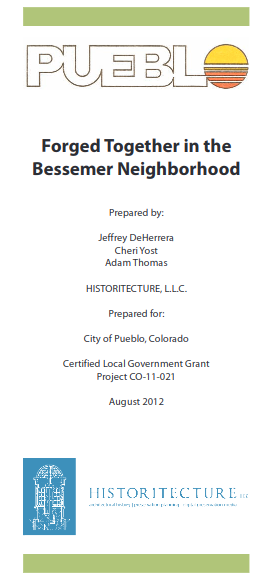Get to Know the Neighborhoods of Pueblo
The full detailed reports are available for download by clicking on the cover to the left of each neighborhood introduction.
“The forging of steel into the sinews of the American economic juggernaut was and is an act of brilliance and bravery — of service and sacrifice.”
“In furnaces over 3,000 degrees Fahrenheit, iron—the structure of planetary engineering, the very essence of inter-stellar creation itself—melts into a blinding white liquid. With the introduction of carbon and various other elements—manganese, chromium, vanadium, and tungsten—what pours forth from the sparking ladles of giants is the soup of American progress—even then hardening into steel for bridges, rail-roads, skyscrapers, appliances, weapons, wires and nails. Forging steel is a demonic ballet. Millions of tons of sparking black coal, gray coke, rusty ore, snowy limestone, smoldering slag,and molten and hardened steel move effortlessly below, be-side, and even above the heads of workers like so many tiny ants. The cacophony is quite literally deafening: stamps and rollers, sirens and whistles, the maddening, ceaseless clang of steel against steel against steel. The air itself breathes of hell, of sulphur, of flame. And then there is the heat. At nearly 2,800 degrees, iron’s melting point, human flesh does not burn—it vaporizes. Thus this ballet is also deadly. The forging of steel into the sinews of the American economic juggernaut was and is an act of brilliance and bravery—of service and sacrifice.”
“Historically known as East Pueblo and Park Hill, the East Side is, outside of the San Luis Valley, one of the very earliest areas in Colorado to be settled by Europeans.”
“The exact definition of what constitutes Pueblo’s East Side neighborhood varies from resident to resident. But one feature is always the same: the East Side is a place set apart. It is a place set apart physically by Fountain Creek, which severs the neighborhood from the rest of the city. It is a place set apart by its erratic, undulating topography. It is a place set apart by varied architectural styles and building types. And it is a place set apart by its economic and cultural diversity. Historically known as East Pueblo and Park Hill, the East Side is, outside of the San Luis Valley, one of the very earliest areas in Colorado to be settled by Europeans. Its river confluence and mesa-top promontories may have attracted Native Americans even millennia before. Certainly the first American explorers encountered tribes at this place. Beyond the length of East Pueblo’s history is the breadth of its legacy. It was a place of struggle and success, where the working and professional classes freely mixed for most of its history. In that way it was unlike any other place in Pueblo.”
“This context traces the story of Pueblo’s Slovenian community, from their immigration from Europe to the present day. ”
“Sometimes the most beautiful gardens grow in the most unexpected places. In 1883, German immigrant Anton Eilers opened the Colorado Smelter, one of the largest ore processing facilities in the United States. Enormous in its own right, it was still dwarfed by the Colorado Fuel & Iron Company’s adjacent Minnequa Works, the largest steel mill west of the Mississippi River.”
“This context traces the story of Pueblo’s Slovenian community, from their immigration from Europe to the present day. Within the text the terms “Slovenian” and “Bojon” are used interchangeably. Bojon is an American slang term referring to those of Slovenian origin. The origins of this term are unclear. However, two possible explanations have emerged. The first involves the fact many Slovene men were named John and dressed in their finest clothes, including bow ties, when applying for work at Pueblo’s smelters or the steelworks. Therefore, the name John and the bow tie were combined to describe the men as Bojons. The second explanation posits immigrants who traveled by train to Paris prior to sailing for the United States overheard Parisians remarking, “Quels beaux gens” or “what handsome people.” So, when they arrived at Ellis Island, instead of declaring themselves to be subjects of the hated emperor Franz Joseph, they instead called themselves “beaux gens,” a term immigration officials recorded as Bojons. Like so many ethnic labels, both the meaning and the perception of the term often depends upon who is using it and in what context.”
From the Introduction - Reaping What You Sow: Harvesting Stories
“Here, the city’s merchant princes and professionals found a retreat from the bustle of the busy downtown and the belching smokestacks of the Colorado Fuel & Iron Company’s enormous Minnequa steelworks. ”
Pueblo’s North Side Neighborhood is one of the most significant collections of residential buildings in southeastern Colorado. Here, the city’s merchant princes and professionals found a retreat from the bustle of the busy downtown and the belching smokestacks of the Colorado Fuel & Iron Company’s enormous Minnequa steelworks. Beginning in the 1880s, Mahlon and John Thatcher, Pennsylvania brothers who became the model Pueblo self -made men, chose to locate their enormous estates in the North Side. They established a trend that would span the next seven decades.
“South Pueblo was a place born of vision, of ambition, and of benevolence. It marked an intersection between the romantic mythology of the American West and limitless—often ruthless—industrial capitalism.”
South Pueblo was a place born of vision, of ambition, and of benevolence. It marked an intersection between the romantic mythology of the American West and limitless—often ruthless—industrial capitalism. For centuries the natives of this land climbed its windswept promontories and arid bluffs to witness the Arkansas River escape the distant, granite spires of the Rocky Mountains and emerge eastward onto the impossible vastness of the Great Plains. Here was a front line of European conquest, where the King of Spain greedily guarded his empire against French incursion, though no monarch would ever step foot on its soil or ever know it as more than arbitrary lines on vague maps. Some Europeans passed through armed with gunpowder, others armed with the Word of God, turning their theology into geography: Sangre de Cristo—Blood of Christ. Empires rise and fall, and thus revolutionaries claimed this land, first the Mexicans and then the Americans. Yet natives and missionaries, kings and revolutionaries could not have imagined what would finally conquer them all and turn these mesas into a metropolis: steel.
“Postwar Pueblo—defined here as 1940 to 1982—was an exciting time when the city witnessed dramatic changes. The key components of the American dream from the individual’s perspective—work, home, consumer goods, education, and freedoms—serve as the organizational framework for this document.”
At no other time in our history was the American Dream so possible for some and so elusive for others as it was in the decades following World War II. Years of unrequited consumer desire followed a decade of want, as the United States emerged from the Great Depression into wartime. Victory in Europe and Japan not only brought peace to large swaths of Europe, Asia, and Africa, but also freed Americans to spend, at last, their unprecedented savings. Buoyed by massive government investment, including the G.I. Bill, federal housing programs, and interstate construction, Americans built and consumed, achieving astonishing affluence envied the world over. Never before could so many achieve the American Dream—or at least its material trappings—so easily.







